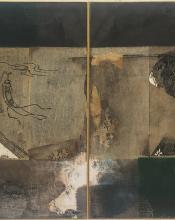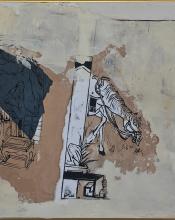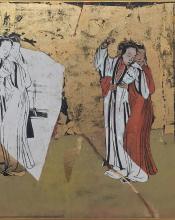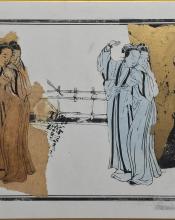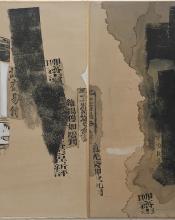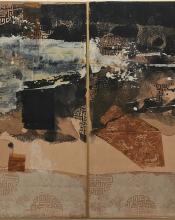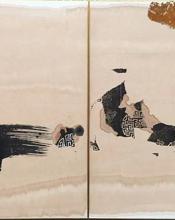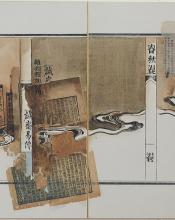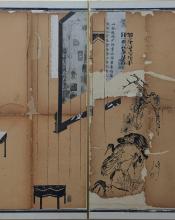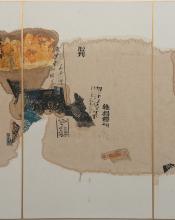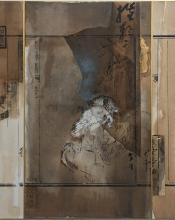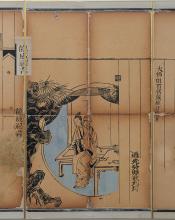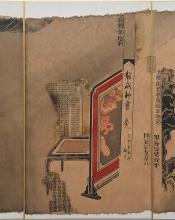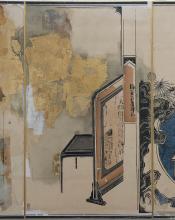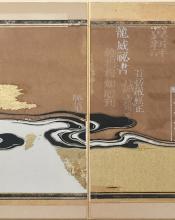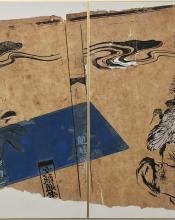Behind the Curtain of the Boudoir — Wang Lifeng Solo Exhibition
Curatorial Statement
Zehui Tang
Wang Lifeng, one of the pioneers of Chinese contemporary abstract art, began his artistic practice in the mid-1980’s. During this period, he refined his use of ready-made materials and symbols that held vivid cultural references to Chinese tradition.
Apart from his practice in mixed-media painting on canvas, works on paper have become a crucial aspect of Wang’s artistic exploration in recent years. The solo exhibition Ji held at Red Gate Gallery in 2013 is the beginning of such direction. If one considers his previous series Qing Mountain as an attempt to create traditional Chinese painting with oil paint, works shown at Ji represents a direct response to the traditional form. The series Ji inherits and deconstructs the memorable figures he replicates in veneration of the Old Masters Chen Hongshou (陈洪绶) and Ren Bonian (任伯年) and collages together the elements with his signature materials such as gold foil, rubbing from stone inscriptions, silk and ancient books. Being an extension of the series Ji, the new works showcased in Behind the Curtain of the Boudoir manifest the first attempt of Wang’s practice in Chinese traditional woodcut techniques.
In the Ming and Qing Dynasties, woodcut printing entered its heyday with the boom and maturation of secular literature. The popular operas and novels such as Romance of the Western Chamber, Kunlun Slave, Water Margin: Outlaws of the Marsh, The Plum in the Golden Vase, and subsequently followed byThe Story of the Stone, Strange Tales from a Chinese Studio were all published with exquisite illustrations made by woodcut printing. The combination of literature and woodcut illustration became a critical method of image dissemination in the era before photography. In addition to this research effort, the artist remakes the plate incorporating his own interpretation and transfers the image onto his paper surface. The episodic woodcuts comprise a genealogy of characters and props which are composed by the artist and appears with gold foils, blocks of colours, and fragments of ancient texts in the series of paintings, forming different stories as the context changes.
Wang Lifeng has created mixed-media paintings on canvas, using the grand Ming and Qing Dynasty as themes years ago. His works on paper today may have drawn its material from the same period, yet the artistic disposition of the work is distinct from the previous series as the artist altered his starting point and choice of medium. Comparing the previous and the latest series, one is elegant and the other vulgar, one solemn and the other humorous, one that enters the palace and the other that stays behind the curtain of the boudoir. Through such approaches, one sees the artist’s multifaceted concerns and responses to traditional culture.
A retrospective of Wang’s artistic journey shows that he is quite a systematic artist who rarely creates sporadically – his work, with careful consideration, always emerges as a “series.” From his portrayal of “Han”, “Tang”, to “Ming” and “Qing” Dynasty, Wang has achieved a systematic reorganization of Chinese culture in his own manner. One may also see the series Qing Mountain and Ji as the branches sprouted from this main stem – it is a more subtle and profound exploration of the history. Only then, Wang’s revisit to and reconstruction of the tradition can be viewed as abundant and vivid.
译/李彦霖 Translated by Yanlin Li

